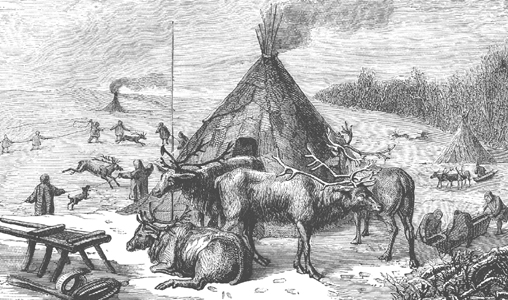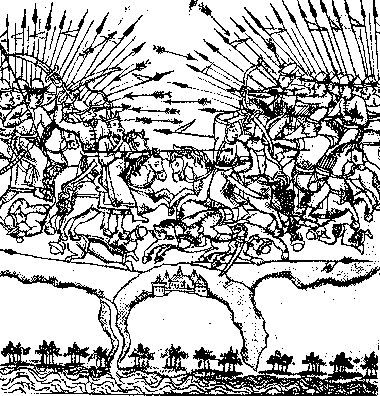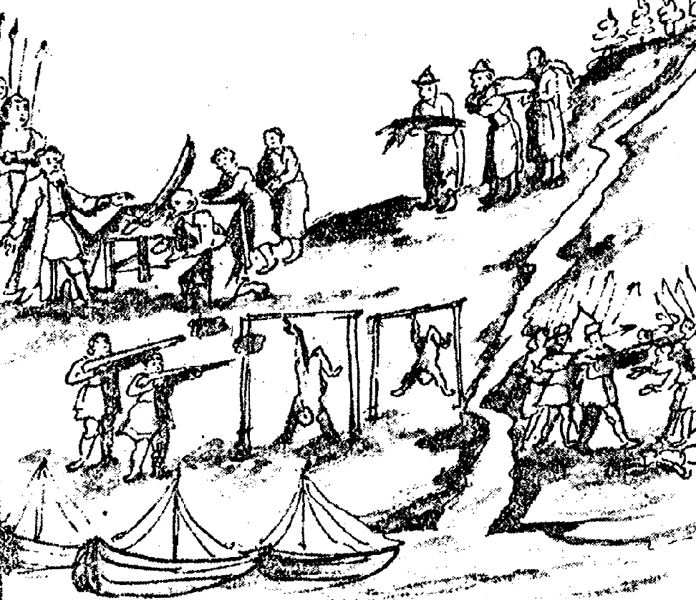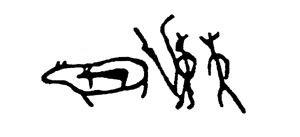 They went ashore to visit the Samoyeds (Nenets) in Pechora. From them they obtained excellent reindeer hides prepared as suede leather and other things. They described the Samoyed way of life and a shaman ceremony.
They went ashore to visit the Samoyeds (Nenets) in Pechora. From them they obtained excellent reindeer hides prepared as suede leather and other things. They described the Samoyed way of life and a shaman ceremony.
which gave its name to a continent, was originally Isker a town and trading centre near the junction of the River Sibirka and the Irtysh, in Western Siberia - just east of the Urals. Excavations have dated it back to the Bronze Age "Potchevash" culture. This became the town of Tobolsk and the finds are in the museum there.
The administrative capital of Sibir had been Chingi-Tura (Tyumen) on the trade route from Bukhara and the trade route called the "Wolf Road" west to Kazan then Moscow.
1493, Chingi-Tura was ruled by Ibak, an Uzbek descendant of Chinghiz Khan whose domain included the surrounding Turkic people as well as the Bashkirs. He murdered his brother-in-law and ruled as Khan of Sibir, until his sister's grandson Marmuk killed him and made his capital at Isker. Ibak's son Murtaz remained with his followers in South Siberia and Centre Asia. His son Kuchum acquired a Muslim education and the desire to collect Uzbek, Nogai, and Bashkir allies - other Muslim peoples, to drive out the pagan Khans of Sibir, brothers and joint rulers, Yediger and Bekbulat.
1555 Yedigar and Bekbulat sent a diplomatic gift of one thousand sable furs to Ivan the Terrible and asked for support against Kuchum in return. Ivan seeing the opportunity open up, demanded the same as an annual tribute - and added "Commander of all Siberia" to his collection of titles".
Next year Yedigar sent a message by a Vogul prince Ivak, to say he could not pay so much tribute as his country was suffering from the attacks of Kuchum.
The court of Muscovy did not have the resources to challenge this. Ivan had conquered Kazan - the Muslim Tatar city (on the trade routes from the Black Sea up the Volga and the Wolf Road) in 1552 with the help of European mercenaries. He would not have done it without the Danish mining engineers who tunnelled under the substantial walls of Kazan and laid explosives to blast open the walls. Then Astrakhan to the south had fallen because it was suffering from desperate poverty and famine at this time. This opened the trade route to Bukhara for Russians and British.
In 1553, British Merchants and Investors had organised an expedition to search for new trade routes by heading north-east across the arctic coast of Siberia. They had employed as consultant, Sebastian Cabot - whose father had pioneered a route from Bristol to Newfoundland under King Henry VII. They had formed the "Mysterie and Company of the Merchant Adventurers for the Discoverie of Cathay and divers other lands". They had three ships ready with captains and crews. As well as lists of supplies and equipment and gifts for natives, a charter was drawn up specifying recommended behaviour in foreign lands for these British representatives of the fifteen year old King Edward VI. They tried to find out more about those unknown lands in the north-east from two Tartar grooms employed in King Edward VI's stables.
The three ships were the Bona Speranza, the Bona Confidentia and the Edward Bonaventure. Sir Hugh Willoughby was the commander of the expedition. Richard Chancellor the captain of the Edward Bonaventura was sponsored by Sir Henry Sidney - a close friend of King Edward VI. Chancellor was given an updated course in mathematics from the King's own tutor and Cambridge don, Sir John Cheke, and was equipped with state of the art navigational instruments commissioned from Gemma Frisus, who also made astronomical instruments for King Edward VI. He also had Robert Recorde's astronomical data, based on that of Copernicus. Chancellor was also equipped with a deck watch to assist him in knowing the local time when at sea and hence the longitude at sea without long complicated astronomical observations which were difficult or impossible in stormy or foggy weather.
The ships sailed up the Thames on May 11th 1553, watched from Greenwich Palace by the King - who was too ill to come down to the ships to see them off. Two months later he was dead. But the three ships knew nothing of this, as by then they were far to the north of Scandinavia. Here off the Lofotan Islands Richard Chancellor lost sight of the Speranza and Confidentia and relying on his own navigational skills continued on his own.
Willoughby decided to spend the winter anchored in a bay on the coast not realizing he had chosen a bleak, cold and uninhabited place. When nomadic Saami discovered the two ships the following summer, every one on board was dead.
Chancellor had found the mouth of the river Dvina, where he landed on 24th August 1553. He and his crew were taken to Moscow for an audience with Tsar Ivan IV on his diamond studded throne. Ivan was delighted. If he was to mainain and enlarge his new empire, he needed the latest technology - above all he needed guns. Not surprizingly, those countries which bordered Russia on the West in Europe were reluctant to sell guns to an increasingly powerful state on their borders. Now the British had found a new route.
On Chancellor's return home, the Muscovy Company was formed. In Moscow and English house was built by Red Square opposite the Kremlin - still there. The Warehouses and depot were built at Kolmogory, near Archangel, on the mouth of the Dvina.
1555 Richard Eden in book "Of the North-East Frostie Seas and Kingdomes lying that way, etc." 1577.
1556 Stephen Burrough with Richard Johnson (who had worked with Richard Chancellor) were sent in the Searchthrift to find the North East Passage to Cathay China). They got to Novaya Zembla then headed back to the mainland, north of Russia.
 They went ashore to visit the Samoyeds (Nenets) in Pechora. From them they obtained excellent reindeer hides prepared as suede leather and other things. They described the Samoyed way of life and a shaman ceremony.
They went ashore to visit the Samoyeds (Nenets) in Pechora. From them they obtained excellent reindeer hides prepared as suede leather and other things. They described the Samoyed way of life and a shaman ceremony.
They reached the Kara Strait on August 10th but was prevented by ice from passing through. They got more information about the route from a Russian walrus hunter.
1580 Arthur Pet and Charles Jackman left England with two ships in search of the North East Passage. They went as far as the Yamal peninsula in August but they had to turn back because of the ice.
In 1561 they set out again to follow the sea and river route to Sibir - and were to visit this country a number of times up to 1581.
Sir Jerome Horsey said of the "Siberian Emperor" that is - Sain Bekbulatovich - at the court in Moscow (where he was deputizing for the Tsar Ivan who was taking a break and had appointed him Tsar in his place): "I heard him tell he had some Englishmen in his countrie at leastways such men of countenances I was, taken with a ship, ordinance, powder and other riches but two years before, that would have passed the River Ob to seek Cathay by the North Sea."
Jackman (who was no more heard of) had been instructed to sail up the Ob to Sibir. He would have got there during the battles between Yermak and Kuchum - so it is possible he and his nine men with him were killed - but there is no evidence for what happened to them at all it is a mystery.
were a dynasty of wealthy Novgorod merchants of Tatar (Mongol) origin well established by the 14th century - the founder Spiridon introduced the Chinese abacus to Russia - still used in shops in the 1980s. By the 16th century their enterprises had expanded across the north of Russia, from the River Dvina to Permia west of the Urals, where they had a salt mine at Solvychegodsk. This was run by Anika Stroganov from the age of 17. Salt was expensive and essential, the Stroganovs lived well on imported luxuries, and the trade of sable furs from Yugria on the East side of the Urals.
Other Novgorod merchants also had interests in Siberia and had established a prosperous town and trading base called Mangazeya, in the far north of Western Siberia, on the delta of the mighty rivers Ob and Yenesey. Boats brought goods up these rivers from as far as China. Boats also sailed along the Arctic coast in summer and a winter settlement was built at the mouth of the River Indigirka - in Yukaghir country in the far north-east.
1557 Anika Stroganov by then 70, went to Moscow determined to destroy competition from Mangazeya. He lied that there was an overland route to Managzeya "there the earth is desolate and empty no men live there - give me this land...". His lies and trust in the ignorance of land so far from Moscow paid off. In 1558 his 20 year old son Grigori received a charter effectively making him ruler of Permia, owner of nearly 6 million acres of forest and rivers, salt mines and iron.
And people. His father had lied and got away with it. The land was inhabited with villages of Permians, Votyaks, Zyrians (Komi) and Cheremis (Mari) as well as Russians already living there, and small Russian monasteries. Anika Stronganov intened that the locals could now be used as slave labour in the salt mines and other industries. He built a palace for his family - in the style of a monastery to make it less obvious. They employed more than 10,000 men in the salt mines, 5,000 to till the land for them. And they engaged German, British and Italian doctors and apothecaries to look after the family and craftsmen and artists to build and embellish their luxury residences.
The Stroganovs mined the iron ore and built blast furnaces to process it. But Ivan the Terrible had given a concession to the British mining engineer Randolph. His agents and employees arrived in Permia - and his mines and blast furnaces were far more modern and efficient. When Anika Stroganov complained to the Tsar about this unfair (to him) competition, the Tsar told him he should be copying the British methods to benefit of his Tsar.
The Stroganovs ignored the conditions of the charter the Tsar had given them. They were supposed to hand over silver, copper and gold that had been mined to the Tsar - so they kept quiet about these. Also against the conditions of their charter, they employed illegal refugees - they wanted cheap labour, and criminals - they wanted thugs to keep the labour force under control.
In 1564 they acquired another 3 million acres, and controlled all towns, factories, docks and fortifications in the land. Local Mordivin, Permians, Cheremis, etc were thrown off their lands or killed if the Stroganovs wanted it, for mining, pasture or crops. In 1568 Anika and his brother Yakov managed to defend their interests against complainants travelling to Moscow and reporting to the Tsar, and acquire another one and a half million acres.
 East of the Urals the countries were no longer so well protected by their allegiance to Sibir. The twin khans Yedigar and Bekbulat were defeated by Kuchum, who made his capital at Isker, now called Sibir. One ofthe battle is shown in this picture. Once of Bekbulat's two wives took her son Seidak to Bukhara, the other took her son Sain to Moscow. This is where he met Jerome Horsey.
Seidak was to return to Sibir to fight Kuchum.
East of the Urals the countries were no longer so well protected by their allegiance to Sibir. The twin khans Yedigar and Bekbulat were defeated by Kuchum, who made his capital at Isker, now called Sibir. One ofthe battle is shown in this picture. Once of Bekbulat's two wives took her son Seidak to Bukhara, the other took her son Sain to Moscow. This is where he met Jerome Horsey.
Seidak was to return to Sibir to fight Kuchum.
1569 Kuchum made a treaty with Ivan the Terrible and agreed to pay tribute to Moscow of 1,000 sable and 1,000 squirrel furs. The treaty with its gold seal was taken to Sibir by Russian officers. Kuchum was ageing and losing his sight, but he had grown up sons by his three wives to lead his armies when it become clear that Ivan was not keeping his side of the Treaty and allowing his subjects to be attacked by the Strognovs.
In 1574 the Stroganov family managed to obtain a charter from the Tsar, giving them Siberia and the right to wage war on the Ostyaks, Voguls, (on the east side of the Urals)Samoyeds, (in the North),Tatars, and Nogai, (to the south) under a 20 year lease - although this land did not belong to the Tsar.
Grigori died in 1575 and his brother Yakov 1579. Grigri's son Nicetas and Yakov's son Maxim inherited the empire.
In 1577 Ivan the Terrible sent troops to tackle the Cossack pirates on the Volga. A number of the pirates under their Ataman Yermak escaped up the river where they were employed by Maxim. He ordered them east of the Urals and on October 1578 they built a fort to spend the winter from which they could invade the land of the Voguls. These were the original Hungarian people, their capital was Pelym which was taken by the Cossacks.
 The picture shows Yermak's men hanging and shooting people to force them to bring valuable furs. There was no stopping Yermak's gang as other low lifes joined them - laden with loot pushed on carts they were more than 5,000 of them. Yermak kept order by getting trouble makers sewn into sacks and thrown in the river.
The picture shows Yermak's men hanging and shooting people to force them to bring valuable furs. There was no stopping Yermak's gang as other low lifes joined them - laden with loot pushed on carts they were more than 5,000 of them. Yermak kept order by getting trouble makers sewn into sacks and thrown in the river.
Kuchum ordered his subject Voguls and Ostyaks to stop collecting yasak (tribute) for the Russians and drafted the men into his army led by his nephew Mametkul.
Maxim had an angry letter from from Ivan the Terrible who had found out what was going on - he appeased the Tsar by sending thousands of furs to Moscow by one of the Cossacks, an ex-con called Koltso, who managed to return with weapons, more men, and a really splendid suit of armour embossed with the double-headed eagle for Yermak.
Yermak was killed in an ambush on an island - he had tried to escape by swimming across the river but his posh armour weighed him down and he drowned.
Ivan the Terrible died in 1584, but Kuchum although now aged, blind, and abandoned by many of his subjects and even his own family, never gave up his battle for his country. Eventually he took refuge with the Nogai and was murdered by them. By this time Sibir was now a Russian town renamed Tobolsk and bands of Cossacks were moving east intimidating local villages and tribes and looking for treasure.
The Cossacks were ruthless - taking what they wanted from the local people to make their winter quarters secure. Heading towards the south and east where people were more prosperous. Bad news travels. The name for "Russian" was the name for "bandit". And the marauding Cossacks found deserted villages. Only one or two old ladies were left. They were tortured in the hope they would betray the location of the people that had fled and their stores. But they had sacrificed themselves so their children could survive. The Cossacks become desperate as winter drew in. They built a fort and half of them went out to hunt for food. When they returned they found their comrades' guns turned on them. They were the food. Local people were horrified. But here in the south-east of Siberia, they were on the borders of the Manchurian Empire, now ruled by the Tungus-Manchurian Manchu dynasty building up a force - aided by technology from Jesuits - who helped them forge their guns, soon to conquer China (in 1644). The Cossacks were now against professional armies of the Manchu headed by the chilling drummers, backed by infantry with handguns and artillery with canons. A border incident was brewing as the Manchu government realized the bandits harrassing their people on their borders were Russians from Moscow.
There was little that Cossacks could take from nomadic peoples in Central Siberia, other than furs. And in 1621, they had taken as much as possible from the Tungus (Evenk) princes and their people. All their sables and other furs, even their coats, and the linings on their skis. Then they were told of a great river further east by which lived people with boats, with cities, with armoured warriors on horseback. With gold and silver and gems. Cattle and horses. People they called Yakut.
 |